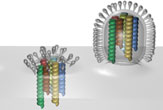
Virologists have long debated whether the genetic material in flu viruses, called RNA, is assembled randomly or systematically. A new study finds it is arranged in an orderly manner similar to human cells.
The discovery could provide a new target for researchers working on anti-viral drugs.
The study focused on the influenza A virus—the type responsible for most flu outbreaks, including the infamous 1918 pandemic.
Researchers used a technique called electron tomography to generate three-dimensional images of the virus and its insides. They then dissected their virtual model to see how various viral parts were put together.
They found that the genetic material for the influenza virus is divided into eight column-like segments, with seven of the columns arranged in a circle around one central column.
The finding raises the possibility of developing a drug that interferes with RNA segment assembly.
"As these segments get incorporated into the [virus] as a set, it suggests these elements could be a target for disruption," said study co-author Yoshihiro Kawaoka from the University of Wisconsin-Madison School of Veterinary Medicine and the University of Tokyo.
Sign up for the Live Science daily newsletter now
Get the world’s most fascinating discoveries delivered straight to your inbox.
"There must be a genetic element in each of the eight segments that allow them to interact."
The work is detailed in today's issue of the journal Nature.









